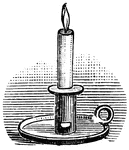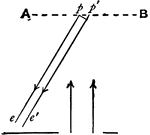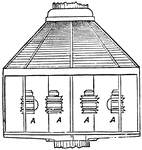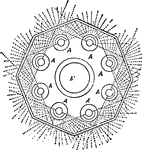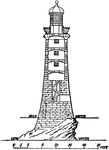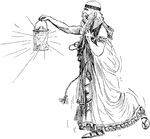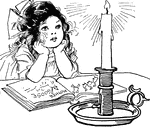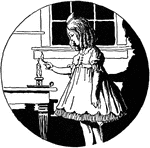
Angle of Vision
"The angle under which the rays of light, coming from the extremities of an object, cross each other…

Arc Lamp
"The arc lamp is essentially a device for automatically separating the carbons when the current is turned…

Arc Light
An arc lamp or arc light is the general term for a class of lamps that produce light by an electric…
Beacon
"Beacons in exposed situations are constructed sometimes of stone, and cement-concrete or cement-rubble,…

Lantern Tower at St. Botolph's; Boston, Lincolnshire
In Gothic architecture, a lantern tower is frequently placed over the center of cross churches, and…
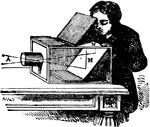
Camera Obscura
"An optical instrument employed for exhibiting the images of objects in their forms and colors, so that…

Camera Obscura
"Camera obscura strictly signifies a darkened chamber, because the room must be darkened, in order to…
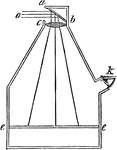
Camera Obscura
"Camera obscura strictly signifies a darkened chamber, because the room must be darkened, in order to…
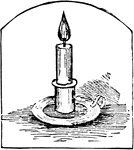
Candle
A cylinder of tallow, wax, spermaceti, paraffine, or other combustible substance, inclosing a wick,…

Candle
A candle is a light source consisting of a solid block of wax and a wick. Pictured is a hand lighting…
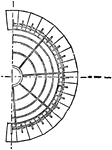
Catadiopteric Light
"Catadioptric Fixed Light.—This apparatus, in which a central burner is used, consists of a dioptric…

Catadiopteric Light
"Catadioptric Fixed Light.—This apparatus, in which a central burner is used, consists of a dioptric…
Coal-gas
"Coal-gas was first used as a lighthouse illuminant at Salvore, near Trieste, in 1817. For many years…
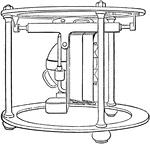
Condensing Apparatus
"Condensing Apparatus for Steamer's Side Lights.—By means of this application of the condensing…

Condensing Apparatus
"Condensing Apparatus for Steamer's Side Lights.—By means of this application of the condensing principle…
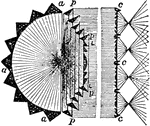
Condensing Light
"Fixed Conensing Light for a Single Sector, 1850.—The holophote Light pLp throws its whole light on…
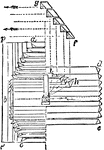
Condensing Octant
"Condensing Octant.—The central fixed apparatus bb with spherical mirror dd throws its rays directly…
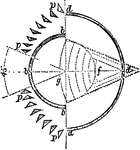
Condensing Octant
"Condensing Octant.—The central fixed apparatus bb with spherical mirror dd throws its rays directly…
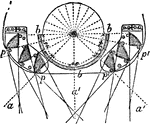
Condensing Quadrant
"Condensing Quadrant.—The fixed apparatus bbb, with spherical mirror behind, throws its rays directly…
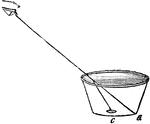
Cup and Shilling
"The refraction of water is beautifully proved by the following simple experiment. Place an empty cup,…
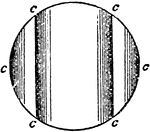
Differential Lens
"Differential Lens.—Horizontal divergence may be obtained to any required amount by varying the radius…

Differential Lens
"Differential Lens.—Horizontal divergence may be obtained to any required amount by varying the radius…
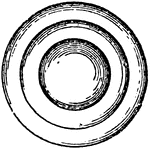
Differential Lens
"Differential Lens.—Horizontal divergence may be obtained to any required amount by varying the radius…
Diffraction
"Throw a sunbeam through a very small opening in the shutter of a darkened room. Receive the beam upon…
Diminish Shadow
"Since A is producing light and larger than object B, the shadow of B continuously shrinks to a single…
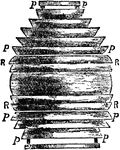
Dioptric Light
"First Application of Total Reflexion to Fixed Lights. In this apparatus Fresnel substituted his totally…
Lighting Fixture
A light fixture or luminaire is an electrical device used to create artificial light.

Floating Lights
"aa is the mast, b tackle hook, c, c brass flanges for fixing parts of lantern together, e and g weather…
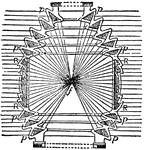
Fresnels Revolving Light
"Fresnel's Revolving Light. —In this form of revolving light the central burner is surrounded by annular…

Fresnels Revolving Light
"Fresnel's Revolving Light. —In this form of revolving light the central burner is surrounded by annular…

Fresnels Revolving Light
"Fresnel's Revolving Light. —In this form of revolving light the central burner is surrounded by annular…
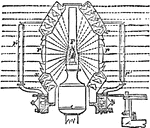
Fresnels Revolving Light
"Fresnel's Revolving Light. —In this form of revolving light the central burner is surrounded by annular…

Electric gas light
"Electric gas lighting is often effected by sparks from the interrupted circuit of a voltaic battery,…
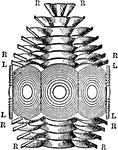
Holophotal Catadioptric
"Holophotal Catadioptric Apparatus Revolving round a Central Flame.—If in place of Fresnel's compound…

Holophotal Light
"Holophotal Fixed Light varied by Flashes.—Fresnel's double agents are here also dispensed with by…

Inverted Image
"Slit A is a very small opening. The light coming from the soldier on the right shines through the slit…

Isometric Holohedral Mirror
This image represents an isometric holohedral mirror positioned to produce a cube by reflection.
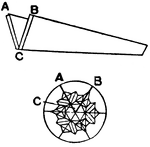
Mirrors in a Kaleidoscope
This illustration shows the arrangement of mirrors in a kaleidoscope (AC and BC), and the patterns formed.
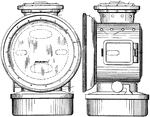
Lamp Body
This lamp body is used for a lighting fixture; an electrical device used to create artificial light.…
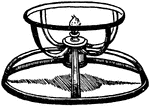
Alcohol Lamp
"Argand got his first suggestion for his burner-- invented in 1780-- from this style of alcohol lamp,…

Arc Electric Lamp
An illustration of an arc electric lamp or an arc lamp which produces light by an electric arc.
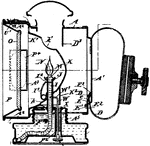
Bicycle Lamp
A headlamp is attached to the front of a bicycle while illuminating the road ahead specially when there…

Cycle Lamp
A lantern is a portable lighting device used to illuminate broad areas. Lanterns may be used for signaling,…

Electric Arc Lamp
An arc lamp or arc light is the general term for a class of lamps that produce light by an electric…

Incandescent Lamp
The incandescent light bulb, incandescent lamp or incandescent light globe is a source of electric light…

Device for Conducting Electricity Into Lamps
A lamp is a replaceable component such as an incandescent light bulb, which is designed to produce light…

Process of Producing Incandescing Bodies for Electric Lamps
The incandescent light bulb, is a source of electric light that works by incandescence which is a general…
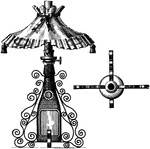
Incandescent Lampshade
A lampshade is a fixture that covers the light bulb on a lamp to diffuse the light it emits. Conical,…
